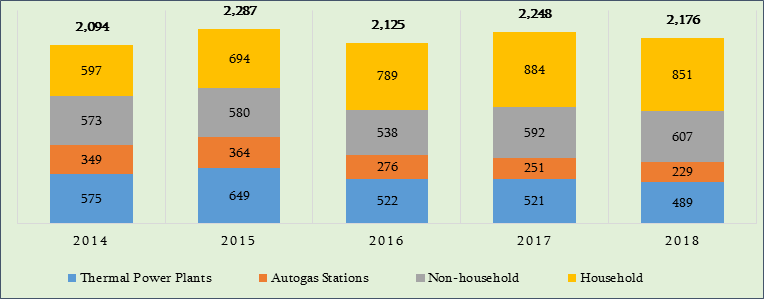Resume: In accordance with the decree of the Minister of Economy and Sustainable Development of Georgia about the approval of the 2018 natural gas balance, the share of gas from Azerbaijan in Georgia’s total natural gas supply was estimated to be 94.2%. In accordance with the 2019 balance, however, the same figure is estimated to be 99%. Of note is that there is no plan to have a gas supply from Russia in 2019.
In regard to factual figures per se and in accordance with the GNERC[1] data, the share of gas from Azerbaijan constituted 97.2% in the total supplies and this figure increased by 3.3 percentage points as compared to 2017. One of the reasons behind the increased share of gas from Azerbaijan could be the monetisation[2] of tariffs imposed for the transit of Russian gas. In particular, when Georgia received in kind payments for Russian gas transit (fully before 2016 and partially in 2017), the country was forced to consume 10% of the supply going to Armenia instead of receiving monetary compensation for the transit. After the monetisation of the tariff, Georgia does not receive natural gas in exchange for transit whilst in light of decreased consumption (2,176 million cubic metres in 2018), supplies from Azerbaijan almost fully meet existing demands and a relatively less volume of Russian natural gas was needed to be purchased in 2018 as compared to the volumes under the previous contract (122 million and 135 million cubic metres of natural gas respectively in 2016-2017).
Azerbaijan’s gas is supplied to Georgia through two alternative pipelines. One part of the total supply is natural gas which Georgia receives in exchange for the natural gas transit through the Shah-Deniz[3] gas pipeline. The second part of gas from Azerbaijan is supplied to Georgia through the Gazakh-Saguramo pipeline operated by SOCAR.
Analysis
At the session of the Sector Economy and Economic Policy Committee of the Parliament of Georgia, the Minister of Economy and Sustainable Development, Natia Turnava, whilst speaking on the country’s energy security, stated that gas from Azerbaijan, which is supplied from two sources, accounts for 95% of Georgia’s natural gas consumption and fully meets the needs of the population and the thermal power plants.
Theoretically speaking, Georgia can receive natural gas from five different sources. Of those sources, the daily capacity of the Mozdoki-Saguramo gas pipeline coming from Russia is 20 million cubic metres. With this pipeline, Russian natural gas can be supplied to Georgia and Armenia. However, in light of the meagre share (less than 10% on average) of Russian natural gas in Georgia’s total gas consumption of the last years, the Mozdoki-Saguramo pipeline is mostly employed for the transit of Russian gas to Armenia. Prior to 2017, in exchange for the transit of natural gas through the aforementioned pipeline, Georgia received 10% of the transited gas as an in kind payment whilst reimbursement has been fully monetised since 2018. See FactCheck’s research on this topic (link 1, link 2 and link 3).
Most of the natural gas consumed in Georgia is supplied by two pipelines coming from Azerbaijan. The daily capacity of the Gazakh-Saguramo pipeline, coming from Azerbaijan, constitutes five million cubic metres and SOCAR (State Oil Company of the Azerbaijani Republic) uses it to supply natural gas to Georgia. The transit pipeline coming from Azerbaijan (South Caucasus Pipeline – SCP) has a projected capacity of 18 million cubic metres per day. However, Georgia has only one connection spot with this pipeline and it is possible to get 3.25 million cubic metres of natural gas per day. It is from this pipeline where Georgia gets natural gas in exchange for the transit of natural gas from Azerbaijan to Turkey as well as optional and additional volumes envisaged under the quotas of the agreement. The capacity of the reverse pipeline of the magistral gas pipeline going to Armenia is 3.14 million cubic metres per day and it possible to receive natural gas from Armenia. This volume, however, is usually negligible. The fifth source of natural gas is local extraction spots where the output of natural gas depends on the factual amount of obtained volumes.
Demand on natural gas in Georgia is 2.2 billion cubic metres on average in the last years with deviations from the median stipulated by climatic conditions or other factors.
Graph 1: Natural Gas Consumption in Georgia

Source: GNERC
In regard to the issue of market supply, the local extraction of natural gas is negligible and its share in the total supply is in the margins of 0.3-04%. Therefore, Georgia is dependent on imported natural gas. Table 1 shows the natural gas supply in terms of supplier countries.
Table 1: Natural Gas Supply in Georgia[4]
|
Supply |
Measure Unit |
2015 |
2016 |
2017 |
2018 |
|
Azerbaijan |
Million Cubic Metres |
2,080 |
2,113 |
2,201 |
2,223 |
|
Market Share |
82.8% |
93.5% |
93.9% |
97.2% |
|
|
Russia |
Million Cubic Metres |
295 |
122 |
135 |
39 |
|
Market Share |
11.7% |
5.4% |
5.8% |
1.7% |
|
|
Armenia |
Million Cubic Metres |
127 |
19 |
0 |
15 |
|
Market Share |
5.1% |
0.8% |
0.0% |
0.7% |
|
|
Local |
Million Cubic Metres |
11 |
6 |
8 |
9 |
|
Market Share |
0.4% |
0.3% |
0.3% |
0.4% |
|
|
Total |
Million Cubic Metres |
2 513 |
2 260 |
2 344 |
2 286 |
Source: GNERC
As illustrated by the table, Azerbaijan is the main natural gas supplier country. As of 2018, imports from Azerbaijan account for 97.2% of the total annual supply and this figure has increased as compared to previous periods. The reason for this could be the full monetisation of the gas transit fee from Russia to Armenia. In particular, fully before 2016 and partially in 2017, the transit fee was paid in kind in the form of Russian natural gas. Therefore, Georgia received 10% of the Russian natural gas supply going to Armenia instead of monetary compensation for the transit. Since 2018, the transit fee has been in a monetary form and, therefore, there is no necessity to consume Russian natural gas.
The Minister’s statement is perhaps based on estimated figures in the gas balance. In accordance with the decree of the Minister of Economy and Sustainable Development of Georgia about the approval of the 2018 natural gas balance, the share of gas from Azerbaijan in Georgia’s total natural gas supply was estimated to be 94.2%. In accordance with the 2019 balance, however, the same figure is estimated to be 99%. Of note is that there is no plan to have a gas supply from Russia in 2019.
[1] Georgian National Energy and Water Supply Regulatory Commission.
[2] Monetary payments instead of in kind payments.
[3] Also known as the South Caucasus Pipeline or the Baku-Tbilisi-Erzerum Pipeline.
[4] The difference between the total consumption and the total supply is stipulated by losses during transportation.







